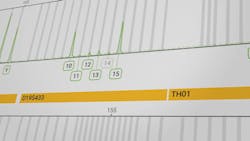Completing the Full Workflow to Interpret Crime Scene DNA
As you might imagine, PG software’s successful track record has led to a rapid rise in its use, particularly in cases in which a violent crime or sexual assault has occurred. Crime labs, however, are continuing to face challenging caseloads. Additional technology adoption can help to alleviate this glut of cases by more rapidly delivering robust intelligence and evaluative information. With that in mind, many labs can now turn to a combination of software solutions which enable them to complete the full workflow, from DNA analysis to interpretation and database matching.
To illustrate how a suite of software applications can be used in a fully integrated workflow, let’s examine a hypothetical case involving the recovery of a firearm used in a homicide. In the early phase of the investigation, no person(s) of interest (POI) have been identified and swabs used to sample areas of the firearm and recover biological material have been extracted. DNA has been recovered and amplified to identify any person(s) that can be linked to the incident.
Using FaSTR™ DNA, an application which rapidly analyzes raw DNA data and assigns a number of contributors (NoC) estimate, the crime lab begins its work by analyzing data output produced by capillary electrophoresis (CE) DNA profiling technology—the primary methodology for separating and detecting short tandem repeat (STR) alleles in forensic DNA analysis.
Using peak detection and sizing algorithms and applying dynamic baselining, FaSTR™ DNA can apply a set of laboratory-customized analysis rules to distinguish artefactual peaks from allelic peaks and estimate the number of contributors in the case. The software can also carry out sample-to-sample or sample-to-database comparison checks, as well as full concordance testing on positive and negative controls. At analysis completion, the results can then be exported as configurable outputs.
In this hypothetical case, the recovered material has generated a DNA profile originating from a suggested three contributors. The NoC assignment provides some empirically derived support for this and initial visual assessment of the contributor DNA mixture proportions provide some insight into varying amounts of DNA from those contributors.
With this information in hand, results can be seamlessly exported to PG software, which can help in linking it to a POI. Unlike previous methods of DNA analysis, which depended entirely on the application of fixed stochastic thresholds and other biological parameters to manually analyze DNA samples, PG software uses a fully continuous model that makes better use of all of the information available within a DNA profile. It proposes hundreds of thousands, if not millions, of different profiles, assesses and weighs how closely these resemble the observed DNA mixture, and then assigns a likelihood ratio (LR) should a POI’s standard sample be available. The LR is a widely accepted standard statistical approach to conveying weight of evidence information.
Because STRmix™ PG software fully integrates with FaSTR™ DNA, the crime lab uses it to run the hypothetical case sample along with other samples in the CE analysis collection in Batch Mode. There, analysis can be configured and compared to available reference samples from any POI. STRmix™ then outputs the useful diagnostic of mixture proportions. The analyst, using their experience and expertise to check this diagnostic against observed results, agrees that the mixture proportions of the proposed three contributors are approximately 4:2:1.
In this case, given the absence of any standard from a POI for comparison, the weights (the primary output of STRmix™ and a representation of the likelihood of the observed results given a tested genotype combination) can be formatted for comparison against a local or national database, such as CODIS.
From this point, the crime lab can turn to a third software solution which uses efficient algorithms to rapidly calculate millions of LRs in differing proposition scenarios and database searches, completing the full workflow. DBLR™, an application which fully integrates with STRmix™, enables the lab to load STRmix™ deconvolutions or single-source profiles from known individuals.
DBLR™ also enables the crime lab to visualize the evidential value by simulating LRs using a range of available propositions. These visual outputs communicate “at a glance” information to interested parties, utilizing the expected LRs for one or many components of DNA profiles for true and non-contributors using randomly generated individuals. DBLR™ is also a powerful kinship calculation and pedigree building tool with utility to build complex and bespoke pedigrees with significant ease. In essence, DBLR™ can calculate any kinship relationship conceivable (including modelling of linkage, mutation and FST).
For the hypothetical case, component three of this mixture appears suitable for comparison. Based on distributions of expected LRs, the lab can expect good discrimination capacity, which will allow it to clearly distinguish true from false donors. DBLR™’s Search Database module can then be used to search component three against saved databases in seconds, leading to a link to an individual if on the database.
Bottom line, utilization of a total workflow solution, which in our hypothetical case was illustrated by combining FaSTR™ DNA, STRmix™, and DBLR™, can rapidly turn raw data into crucial intelligence and evaluative information which investigators, in turn, can use to help resolve cases.
About the Author
A former reporting officer for the Home Office Forensic Science Service, Adam McCarthy has presented expert testimony in both biological and firearms casework examinations. McCarthy joined the STRmix team in 2015 and provides representation for the group in the United Kingdom, Europe, and RoW regions. For more information, visit http://www.strmix.com.

